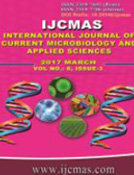


 National Academy of Agricultural Sciences (NAAS)
National Academy of Agricultural Sciences (NAAS)

|
PRINT ISSN : 2319-7692
Online ISSN : 2319-7706 Issues : 12 per year Publisher : Excellent Publishers Email : editorijcmas@gmail.com / submit@ijcmas.com Editor-in-chief: Dr.M.Prakash Index Copernicus ICV 2018: 95.39 NAAS RATING 2020: 5.38 |
Soil samples were drawn in rabi season of 2013-14 from an ongoing experiment initiated in 2011 on “Phosphorus management in wheat under different tillage practices in sequence with sorghum crop” at the Research Farm of CCS HAU, Hisar. The experiment is laid out in a split plot design with four replications with four tillage treatments (Zero Tillage, conventional tillage and minimum tillage) and four P rates in wheat only at 0, 45, 60 and 75 kg ha-1. P fertilization caused a significant increase by 36.5, 64.7 and 140.8% in Saloid-P over control while under zero tillage (ZT) it was only 12.0 and 4.5 %, respectively over conventional (CT) and minimum tillage (MT). Saoid-P was the least amongst all the fractions and constituted only about 2% of inorganic P extracted from the samples. A slight insignificant increase in the Al-P or Fe-P in surface soil (0-15 cm) over ZT, CT and MT while P application increased the values from 34.2 in control to 50.4 for 75 kg dose for Al-P while the corresponding values for Fe-P were 42.0 60.6, respectively. Distribution in different fractions followed the sequence: Ca-P > Fe-P > Al-P > Saloid-P and all these fractions were significantly interrelated.
 |
 |
 |
 |
 |